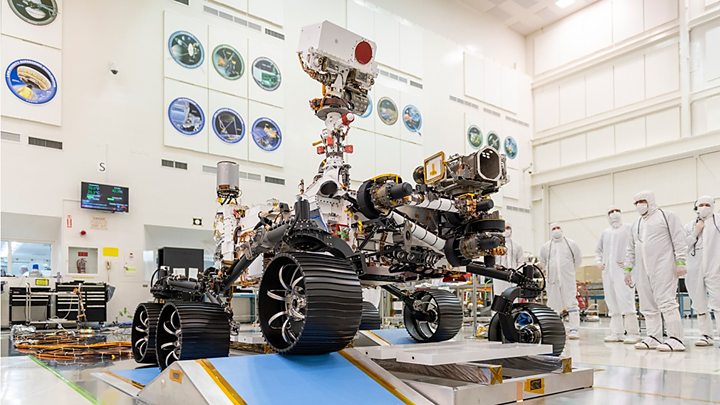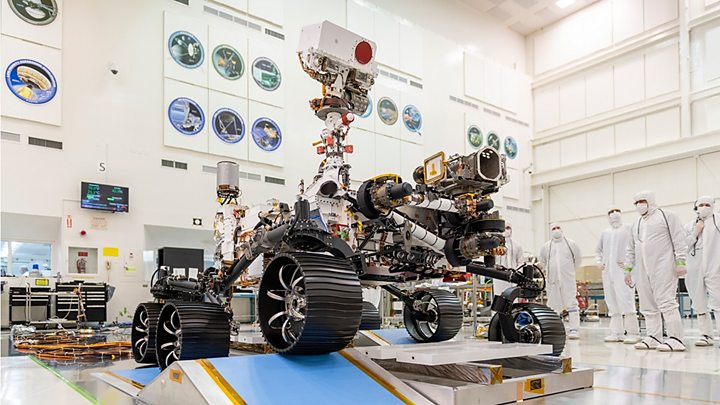Nasa’s 2020 rover: Can we finally answer the big question about Mars?
The US space agency’s next rover will hunt for life’s traces among the rocks of the Red Planet. …


Media playback is unsupported on your device
Exactly a year from now, a capsule will come hurtling through the atmosphere of Mars with the Americans’ next big rover. If it survives the “seven minutes of terror” that describe its descent to the surface, the new robot promises a very different mission to all those that have gone before it.
Because although Mars 2020 (a new name is coming) looks like a simple copy of the Curiosity vehicle of 2012, its goals take a decisive turn towards answering the most fundamental of questions: is there – or has there ever been – life on the Red Planet?
Recent investigations have concentrated on characterising the “habitability” of Mars.
That’s to say, these prior missions asked only if past conditions were conducive to biology. A less direct approach.
Mars 2020, on the other hand, will be engaged in an explicit hunt for life’s traces.
Undeniably it’ll be a difficult quest. Evidence for life on the early Earth always attracts a degree of scepticism, even controversy, and laboratory equipment the size of a large room is often required to back up a claim.
So how will people react if a rover finds something intriguing imprinted in billions-of-years-old rock on another planet?
2020 mission scientist Jim Bell from Arizona State University is candid in his response: “We can make a claim about a biosignature, but it’s not clear to me anyone would believe us,” he said.
“So, let’s bring the samples back. So if those extraordinary claims are made, they can be verified.”
This then is the strategy for Mars 2020: Find something remarkable and cache it for later return to one of those big Earth laboratories.
The rover will trundle across equatorial Jezero Crater seeking out rocks that look as though they might have been laid down in the presence of biology.
The best examples will be drilled and sealed in small tubes the size of whiteboard markers. These canisters will then be placed on the surface for a later mission to pick up and take home.
But what would putative biosignatures look like?
A good example, says Katie Stack Morgan, might be remnants of finely layered, dome-like structures associated with ancient communities of microbes. On Earth we know such structures as stromatolites, which form at the edges of salty lakes and lagoons.
It’s all about recognising tell-tale patterns, textures, and chemical compositions, the deputy project scientist told BBC News: “What [these microbes] leave behind in the rock record are very thin layers, but with concentrations of particular elements or organics at those repeated intervals that represent the ancient fossilised microbial mat. So as those mats grow, they basically form the rock. And so we’re looking for those fine laminations with concentrations of organics or certain elements that wouldn’t be expected if these things were just abiotic, or didn’t involve life.”
When Curiosity landed in Gale Crater in 2012, scientists were uncertain about its history, how the mountain at its centre formed and what sort of influence water may have played in the evolution of the deep depression.
Jezero carries far more certainty. Satellite pictures clearly illustrate the outline of a once great lake and the delta that fed it.
Enticing is the sliver of carbonate rocks that seem to mark what would have been the palaeo-lake’s shoreline.
“When we think of carbonates on Earth, we think of reefs and we think of shallow warm water,” said Dr Stack Morgan.
“We don’t know that we’re going to find reefs on Mars but we do think with these shallow waters where carbonates were precipitated, it could be that we had organisms that were making use of that carbonate just like we have here on Earth in shallow water environments.”
Curiosity has astonished us with its discoveries of river-worn pebbles and lake muds that point to periods of abundant water moving across Mars early in its history.
But the veteran rover’s instrumentation – frustratingly – can only grasp a course, or bulk, view of the chemistry that persisted at the time. It must crush up its samples before testing them. 2020, alternatively, will carry instruments that will be able to examine a rock’s fine-scale textures while at the same time mapping the detailed elemental distribution within those textures.
Indeed, everything about Mars 2020 should be regarded as a step up on what’s gone before, believes Dr Bell.
The Arizona scientist is leading on the main camera system that sits atop the rover’s mast.
“They look like the MastCams on Curiosity; they’re in the same place. But unlike the Curiosity cameras, ours will zoom from wideangle all the way to telephoto. So, we’ll collect a lot more stereo and 3D data. All that was possible with Curiosity, but it was a little more cumbersome.
“We also have microphones. We’re hopeful that we’ll be able to capture some of the sounds of entry, descent and landing; and some of the sounds of driving around, merging that sound with the video that we can take.”
The rover has recently arrived at Nasa’s Kennedy Space Center in Florida to begin its final preparations for launch. This will take place between 17 July and 5 August.
It’s a seven-month cruise to the Red Planet.
Engineers have targeted a touchdown for shortly after 20:30 GMT on Thursday, 18 February, 2021.
Jonathan.Amos-INTERNET@bbc.co.uk and follow me on Twitter: @BBCAmos


